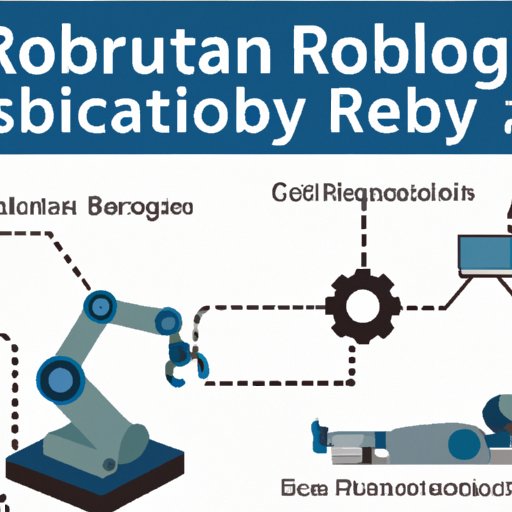Introduction
Robotics is a branch of engineering that specializes in the design, manufacture, and operation of robots. A robot is an autonomous machine that is able to perform tasks without human intervention or control. Robots are used in a variety of industries and have become increasingly popular in recent years due to advancing technology. This article will explore the various applications of robotics across industries and examine the benefits and challenges associated with their use.

Examining the Applications of Robotics in Manufacturing
Robots are widely used in manufacturing to automate processes, improve efficiency, and reduce costs. According to a study by the International Federation of Robotics (IFR), “the automotive industry has the highest penetration rate of robots, followed by the electrical/electronics industry, metal and machinery industry, and rubber and plastics industry.”
Robots offer several advantages in manufacturing. They are capable of performing repetitive tasks quickly and accurately and can operate 24 hours a day without breaks or fatigue. They also help to reduce labor costs and improve product quality. Additionally, robots can be programmed to handle hazardous materials, eliminating the need for human workers to be exposed to these substances.
However, there are some drawbacks to using robots in manufacturing. They require a significant upfront investment and can be difficult to maintain and repair. Additionally, robots may not be able to adapt to unexpected changes in production, resulting in delays or errors.

Exploring the Benefits and Challenges of Robotic Surgery
Robots are increasingly being used in surgical procedures to improve accuracy and safety. Robotic surgery allows surgeons to perform complex operations with greater precision, as robots are able to make smaller and more precise movements than humans. Additionally, robotic surgery reduces the risk of infection, as robots are not exposed to the same germs as human surgeons.
However, robotic surgery is not without its drawbacks. It is expensive and requires highly trained personnel to operate the robots. Additionally, robotic surgery is still in its early stages and may not be suitable for all types of surgeries.
Analyzing the Role of Robots in Automated Logistics
Robots are being used in warehouses and other automated logistics systems to improve efficiency and reduce costs. Automated logistics systems utilize robots to move goods from one location to another, reducing the amount of manual labor required. Additionally, robots are able to work faster and more accurately than humans, resulting in fewer mistakes and improved productivity.
However, automated logistics systems come with their own set of challenges. They require a significant upfront investment and can be difficult to maintain and repair. Additionally, robots may not be able to adapt to unexpected changes in production, resulting in delays or errors.
Investigating the Use of Robotics in Education
Robots are increasingly being used in educational settings to engage students and enhance learning. Robots can be used to teach students about programming, robotics, and other STEM topics. Additionally, robots can help to motivate students and make learning more enjoyable.
However, there are some challenges associated with using robots in education. For example, robots may not be able to adapt to different learning styles and may lack the ability to interact with students in a meaningful way. Additionally, robots can be expensive and may require specialized training for teachers and students.

Assessing the Impact of Robotics on Society
Robots have had a significant impact on society, both positive and negative. On the positive side, robots have improved safety and increased efficiency in many industries. Additionally, they have enabled us to explore space and conduct research in areas that would otherwise be inaccessible.
However, robots have also had some negative impacts on society. For example, they have led to job losses in certain industries, such as manufacturing and transportation. Additionally, robots can be used for unethical purposes, such as surveillance and data collection.
Conclusion
This article has explored the use of robotics across industries and examined the advantages and disadvantages of their applications. In manufacturing, robots offer several advantages, such as improved efficiency and reduced labor costs. In surgery, robots can provide greater precision and reduce the risk of infection. In logistics, robots can improve efficiency and reduce costs. In education, robots can engage students and make learning more enjoyable. Finally, robots have had both positive and negative impacts on society.
Overall, it is clear that robots are becoming increasingly important in our lives and will continue to play a major role in many industries in the future. Further research is needed to understand the implications of robotics on society and determine how best to utilize this technology.
(Note: Is this article not meeting your expectations? Do you have knowledge or insights to share? Unlock new opportunities and expand your reach by joining our authors team. Click Registration to join us and share your expertise with our readers.)
